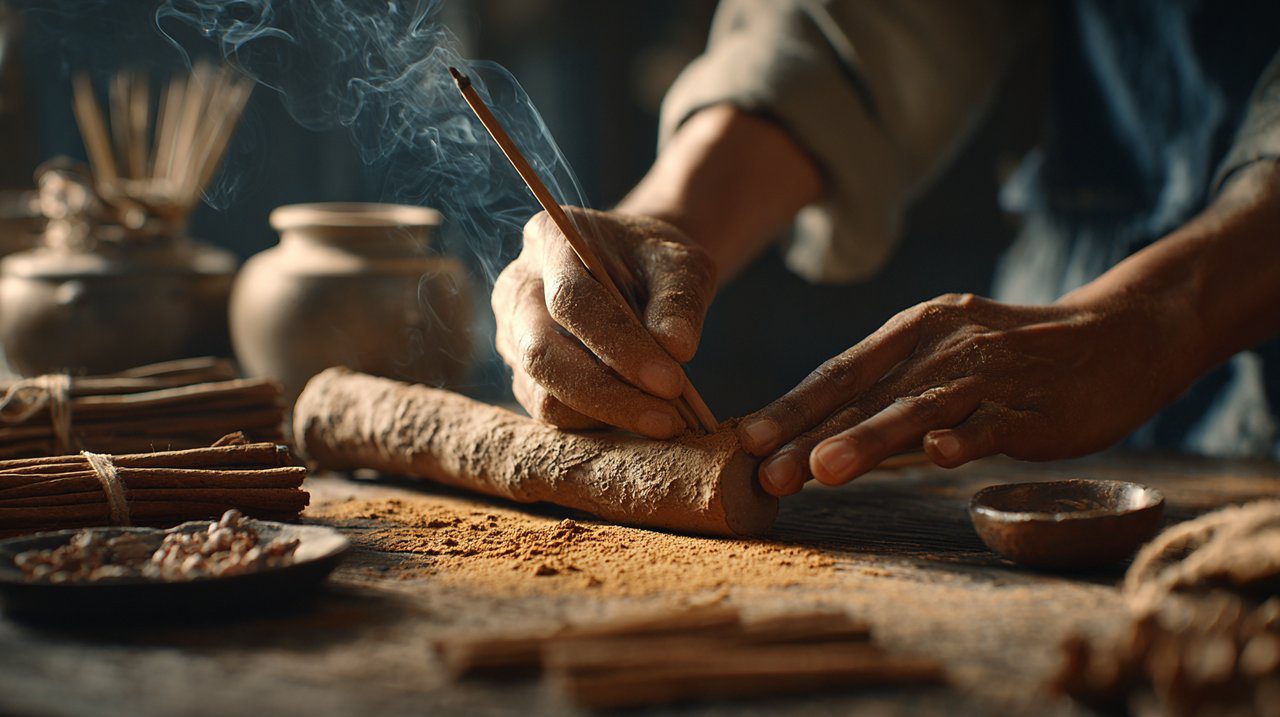Sandalwood Incense: A Guide to Its Sacred History, Spiritual Power, and Conscious Use
What if a simple scent could effortlessly transport you across vast stretches of time, connecting your very breath to the profound wisdom of ancient sages and the serene quiet of sacred rituals? This isn’t just a hypothetical question. Sandalwood stick incense holds precisely that kind of power, acting as an aromatic thread woven deeply through human history.
More than just a pleasant aroma, it’s a powerful tool that beautifully bridges age-old wisdom with our contemporary spiritual practices. In this guide, we’ll embark on a journey to truly understand its fascinating origins, its deep spiritual significance, and how you can mindfully integrate it into your own life.
The Whispers of Time: Sandalwood Incense Through History
Ancient Roots and Global Journeys
Our story begins in the dry deciduous forests of India, where sandalwood’s uniquely fragrant wood first captivated ancient civilizations. Its distinct, soothing aroma quickly became a symbol of spiritual purification and a revered offering.
Historical records, some dating back over 4,000 years, clearly show its central role in Vedic rituals and early Buddhist practices. From these sacred beginnings, bustling trade routes carried sandalwood across Asia, gently influencing cultures from the bustling markets of China to the tranquil temples of Japan.

Cultural Significance Across Civilizations
Across various traditions, sandalwood has held a place of honor. Let’s look at a few examples:
- In Hinduism, sandalwood paste lovingly adorns deities and devotees alike, a potent symbol of purity and unwavering devotion. Its rising smoke is believed to carry prayers directly to the heavens.
- For Buddhists, sandalwood is cherished for its profoundly calming properties, used to aid deep meditation and to consecrate sacred spaces. Monks have long incorporated its distinctive scent into their daily spiritual disciplines.
- Throughout East Asia, sandalwood incense became a staple in temples and homes, consistently fostering an atmosphere of reverence and quiet contemplation.
It truly transcends mere fragrance, acting as a powerful spiritual conduit that connects us to something deeper.
Beyond Scent: Unveiling Sandalwood’s Spiritual Power
Purification and Sacred Spaces
One of sandalwood’s most cherished traditional roles is its believed ability to cleanse negative energies from a space. This purification creates an optimal, harmonious environment for any spiritual work or quiet reflection you might undertake.
Its subtle, woody aroma acts like a gentle broom for the mind, helping to clear mental clutter and prepare you for deeper states of awareness. Many practitioners consider it an essential tool for consecrating altars or simply making a personal meditation corner feel truly sacred.
Enhancing Meditation and Zen Practices
For those who meditate, sandalwood serves as a wonderful anchor, gently guiding the mind towards a profound stillness. Its consistent, calming fragrance naturally minimizes external distractions, helping you sustain focus for longer periods.
It’s particularly valued in Zen practices for its remarkable ability to deepen concentration and foster a genuine sense of inner peace. The aroma itself encourages a slower, more meditative breath, helping to align your mind and body in harmony.
Connecting with the Divine
Many spiritual traditions view sandalwood incense as a direct, fragrant bridge to the divine. Its rising smoke beautifully symbolizes the ascent of our prayers, intentions, and deepest aspirations.
The scent is often associated with higher consciousness, gently aiding practitioners in connecting with spiritual guides or their own profound inner wisdom. It effortlessly fosters an atmosphere conducive to deep introspection and revelation.
The Ritual Art: How to Use Sandalwood Stick Incense
Sacred Preparations
Before you even light your incense, take a moment to prepare your space. Ensure it’s clean and free from clutter; this physical clearing beautifully mirrors the mental preparation needed for effective spiritual practice.
Next, choose a sturdy, heat-resistant incense holder to safely catch the ash. Position it in a well-ventilated area, but be mindful to keep it away from direct drafts that might accidentally extinguish the flame.
Mindful Burning Techniques for Inner Peace
So, how to burn incense correctly? It’s a simple process, but doing it mindfully makes all the difference. Hold the stick at a slight angle and carefully light the tip until you see a small flame appear.
Gently blow out the flame, allowing a small ember to glow softly and begin releasing its fragrant smoke. Now, simply observe the smoke as it rises, letting its presence gently guide your breath and focus. This seemingly simple act transforms into a truly mindful ritual, calming your nervous system and bringing you into the present moment.
Integrating into Daily Life and Chakra Balancing
Sandalwood incense isn’t just for formal meditation. It can beautifully elevate your daily routines, like reading a good book or journaling your thoughts. Its scent creates a serene and inviting backdrop for quiet reflection.
Interestingly, it’s often associated with the root and third eye chakras, making it a valuable aid for chakra balancing practices. The grounding and clarifying effects it offers can support both inner stability and intuitive insights.
From Forest to Flame: The Essence of Authentic Sandalwood
Diverse Types and Their Unique Sandalwood Properties
When we talk about true sandalwood, we’re often referring to Santalum album, known as Indian sandalwood. It’s highly prized for its rich, creamy, and wonderfully lasting aroma, and its key sandalwood properties include high concentrations of santalol.
But the world of sandalwood is diverse! Other varieties, like Australian sandalwood (Santalum spicatum), offer a drier, earthier scent profile. Then there are Fijian and Hawaiian sandalwoods, each with their own unique aromatic nuances. Understanding these distinctions is key to truly appreciating the full spectrum of sandalwood’s essence.
Sustainable Sandalwood Cultivation and Ethical Sourcing
It’s important to acknowledge that, historically, overharvesting severely threatened wild sandalwood populations. This is why sustainable sandalwood cultivation practices are absolutely crucial today, both for its survival and for ethical sourcing.
Responsible growers are now implementing thoughtful, long-term planning, ensuring trees can mature for decades before being harvested. This not only protects the delicate ecological balance but also secures the future supply of this precious resource. As consumers, we can support these ethical practices by actively seeking out certified sustainable products. Our choices directly impact the preservation of this precious resource for generations to come.
The Ancient Craft of Incense Making
The journey from sandalwood heartwood to a fragrant incense stick is a meticulous and ancient craft. Traditional incense making often begins with grinding the precious wood into an incredibly fine powder.
This powder is then carefully mixed with natural binders and water to form a pliable dough. Skilled artisans then hand-roll this dough around a thin bamboo core, creating the familiar stick shape. Finally, these sticks are carefully dried, a critical step that preserves their aromatic integrity and ensures their lasting quality.

Sandalwood stick incense, from its ancient origins to its modern revival, remains a potent symbol of purity, peace, and profound spiritual connection. It is more than just a fragrance; it is a powerful, accessible tool for mindfulness and deep introspection.
As its delicate smoke unfurls, it gently invites us to pause, to breathe, and to reconnect with a wisdom that truly transcends time. This brings us back to our initial question: how can a simple scent connect us to so much? It’s by offering a pathway to inner harmony and a deeper understanding of ourselves.
Why not consider integrating this sacred aroma into your own daily rituals? Explore the diverse world of authentic sandalwood and experience its transformative power for yourself, discovering how its ancient whispers can beautifully guide your modern journey towards inner peace.
💡 الأسئلة المتكررة
Sandalwood incense has a history spanning over 4,000 years, originating in India's forests. It played a central role in Vedic rituals and early Buddhist practices. In Hinduism, sandalwood paste is used for purification and devotion, with its smoke believed to carry prayers heavenward. Buddhists utilize its calming properties for meditation and consecrating spaces. East Asian cultures also incorporated it into temples and homes to foster reverence and contemplation.
Sandalwood incense is traditionally used to cleanse negative energies from a space, creating a harmonious environment for spiritual work. Its aroma helps clear mental clutter, preparing individuals for deeper awareness. For meditation, it acts as an anchor, minimizing distractions and fostering stillness and focus, particularly valued in Zen practices. It also encourages a slower, more meditative breath, aligning mind and body.
To mindfully burn sandalwood incense, first prepare your space by ensuring it is clean and free of clutter. Use a sturdy, heat-resistant incense holder in a well-ventilated area, away from drafts. Light the tip of the incense stick at a slight angle until a small flame appears, then gently blow it out. Observe the glowing ember and the rising smoke, allowing its presence to guide your breath and focus, transforming the act into a mindful ritual.
True sandalwood often refers to Santalum album (Indian sandalwood), prized for its rich, creamy aroma. Other varieties include Australian (Santalum spicatum) with a drier, earthier scent, and Fijian and Hawaiian sandalwoods, each with unique nuances. Historically, overharvesting threatened wild populations, making sustainable cultivation and ethical sourcing crucial. Consumers can support this by seeking certified sustainable products to ensure the resource's future.
Sandalwood incense can elevate daily routines by creating a serene backdrop for activities like reading or journaling. It is also associated with the root and third eye chakras, making it a useful aid for chakra balancing practices. Its grounding and clarifying effects can support inner stability and intuitive insights, contributing to overall well-being.








